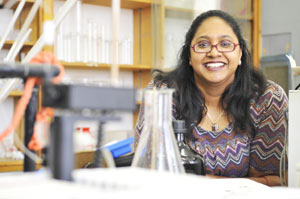Schools going green
06 March 2009 | Story by Chris McEvoy |
| Go green: Pavs Pillay's Green Change Room Audit Project is meeting with great success in local schools. |
A UCT project that teaches high school learners how to "live green" is being implemented in eight schools by the Cape Town Municipality.
Still in its pilot phase, the Green Change Room Audit Project is the brainchild of Pavs Pillay of the university's Marine Research Institute (MA-RE), in partnership with the African Centre for Climate & Earth System Science (ACCESS), the City of Cape Town, UCT's Centre for Criminology, the Embassy of Finland-SA and private company Steadfast Greening.
"The project is aimed at making learners aware that the environment is not something "out there", but their immediate living space," explains Pillay. "Learners need to be informed how climate change will affect their immediate lifestyles, which will hopefully create awareness that results in behaviour changes towards green and global living.
The Green Audit toolkit comprises a learner's information and activities booklet, an educators guide, and "smart living" activity sheets. The toolkit focuses on sustainable living, explored through themes such as water, waste, energy and biodiversity. Learners are taught how to audit their schools and to calculate its carbon footprint.
"We want kids to see the impact they're making on the environment in their every day activities," says Pillay.
In the project advantaged and disadvantaged schools are paired, so that learners and educators from different backgrounds have the opportunity to learn from each other.
Pillay outlined the project at the second African Science Communication Conference in the Midrand in February where, she reports, it was very well received.
"I have been inundated with requests for the toolkit," she says.
Pillay hopes to involve the South African Agency for Science and Technology Advancement the project when it extends its reach beyond the Western Cape. This work is licensed under a Creative Commons Attribution-NoDerivatives 4.0 International License.
This work is licensed under a Creative Commons Attribution-NoDerivatives 4.0 International License.
Please view the republishing articles page for more information.










